
Fruits You Can Grow Indoors
Are you ready to enter the sweet and addictive world of indoor fruit growing? Standard house plants add a touch of beauty to any room, but why not grow varieties that'll reward you for all of your hard work? Dwarf peaches, lemons, limes, and bananas are as tasty as they are eye-catching! Heck, you can even grow coffee in your living room!
Humans started practising agriculture around 10,000 years ago; a lot has changed since then. Many of us choose to grow food outdoors, which leaves us subject to our local climate and weather patterns. However, modern structures such as greenhouses enable us to create ideal microclimates. But growers can take things one step further and grow inside their homes. Our houses are insulated, equipped with central heating and water pipes, and illuminated by powerful lights. Just like our homes keep us cosy and protect us from the elements, they also serve as the perfect location to grow a wide variety of exotic fruits that would quickly perish out in the garden.
Below, we’re going to explain the benefits of growing fruit plants indoors, as well as the potential problems you could run into. Then, you’ll discover ten of the best species that perform great between four walls. Go above and beyond the likes of monstera and snake plants, and grow something indoors that you can actually yield a harvest from!
Why grow fruits indoors?
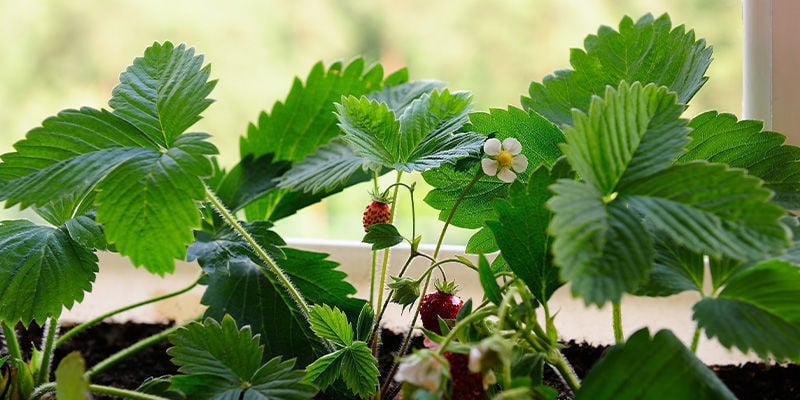
Why grow fruit indoors? There’s only one way we know how to reply to such a question: Why not? You’re already paying the bills to keep yourself warm, hydrated, and illuminated, so why not introduce some botanical companions that benefit from these environmental variables, into your abode? We’re not just talking apples and pears here; your house has the potential to supply you with figs, peaches, and even olives!
The top reasons to grow fruit plants inside your home include:
- Controlled environment: Compared to gardens, houses are very environmentally stable. They’re often warm, slightly humid, and well-lit enough to enable their human occupants to carry out their day-to-day activities. It just so happens that our living conditions are also favourable to many types of fruiting plants. But growers can take extra steps to make sure they grow well, including frequent watering and additional synthetic light. All the while, these plants remain safe from adverse weather and fluctuating sunlight exposure.
- Year-round harvests: Modern houses generate and trap heat exceptionally well. Even when frost grips the ground outdoors, things remain toasty inside. This allows growers even located in cold climates to grow exotic fruit plants all year long.
- Space efficiency: Many fruiting plant varieties are specially bred for tight indoor spaces. If you have an empty windowsill or corner of a room, you can make use of it by growing fruit in your own home. Not only do such plants play an ornamental role, but they also produce fruits, in varying quantities, that taste good and feel rewarding to harvest.
When to sow seeds?
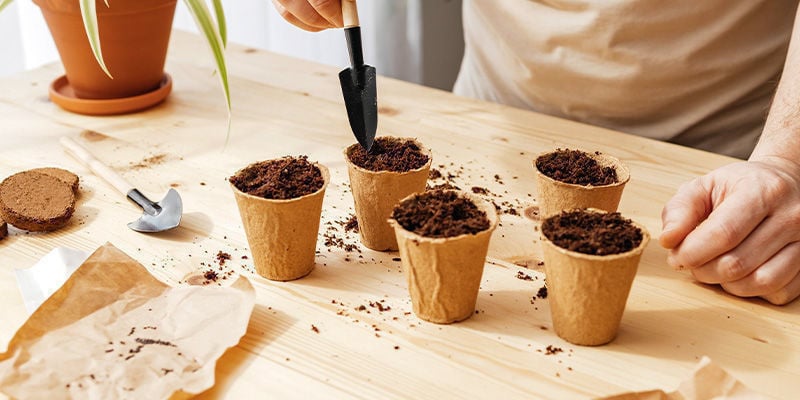
Growing successfully outdoors means carefully monitoring the sowing times for each plant that you intend to grow. However, growing fruit plants indoors from seed erases this need to pay attention to the details. You can germinate fruit plant seeds whenever you please. With that said, timing your sowings with what’s happening outside can save you some cash. For example, spring sowings will mean more heat and light exposure when germinating on a windowsill, requiring less provided by you.
Depending on your level of patience, you don’t have to start fruit plants from seeds at all. Compared to annual vegetable varieties, some fruits take a very long time to germinate and become established. If you’re short on time or want to harvest as soon as possible, then you have the option of buying seedlings or even mature plants.
Potential plant problems
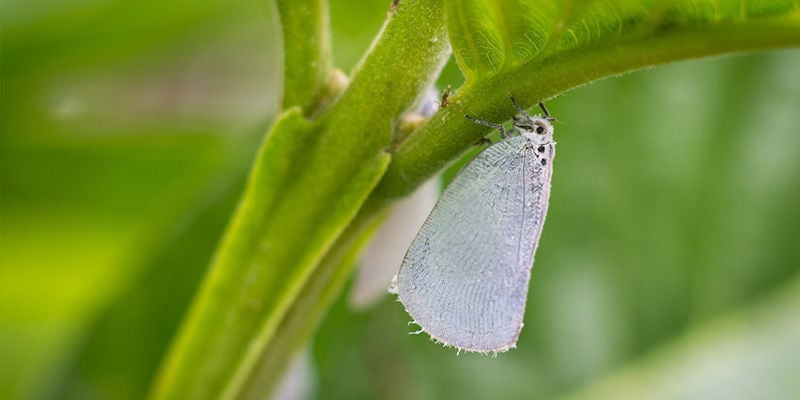
Indoor growing certainly offers a host of advantages. However, plants aren’t immune to specific problems just because they’re located in the protection of a house. Pests, diseases, and other issues can slow things down or terminate a grow altogether if managed incorrectly. Check out some of the most common problems when growing fruit plants indoors:
- Pests and disease: A variety of pests and disease that afflicts outdoor plants can also wreak havoc on those grown indoors. While infestations are more uncommon, insects such as aphids, whiteflies, spider mites, and fungus gnats can gain access to indoor spaces through numerous vectors, including contaminated soil and plant material. Plant diseases, such as powdery mildew and root rot, can also impact indoor plants owing to mismanaged humidity levels and poor watering practices.
- Under-watering and overwatering: Much like plants cultivated in greenhouses, those grown in a living room or kitchen don’t experience the luxury of frequent rainfall. It doesn’t take much to douse a houseplant with water every now and then. However, and somewhat surprisingly, watering issues are often the reason house plants die. Too little water can cause plants to become stressed and stunted, whereas too much can cause the roots to rot in situ. Carefully researching the water demands of each species you grow will help you avoid both of these outcomes.
- Nutrient deficiencies: This problem can affect plants regardless of their growing environment. Poorly designed potting mixes and feeding schedules can cause plants to run low on nutrients that they need not only to grow optimally but to survive.
- Light insufficiency: Without direct sunlight, indoor spaces can remain dark and gloomy all year long if not properly illuminated. Some indoor fruit plants need less light than others, but all varieties need ample amounts to photosynthesise and produce a worthwhile yield. If you don’t have the luxury of a conservatory or large south-facing window, you might need to install supplementary lighting to help your plants thrive. This will require special grow lights, not just a new lamp.
10 fruits you can grow indoors
Right then, you’ve discovered that you can grow delicious and nutritious fruit plants inside your home. You’re also aware of the advantages of doing so, as well as some of the potential issues that can arise. So, let’s get into the meat (or fruit) of the matter! Check out the 10 best fruit plants to grow in our home.
Lemon

Hold on—unless you’ve got ceilings as high as those in Buckingham Palace, surely you can’t squeeze a lemon tree into your living room? Well, this is where the wonders of selective breeding come into play! Ingenious growers have worked hard over the years to produce dwarf lemon trees that rarely exceed a height of 1m. Varieties such as Dwarf Improved Meyer have become popular for their small height and sweet and tangy fruits.
Dwarf lemons will grow happily in 30cm containers close to a south-facing window or positioned near strong LED lights. Use a potting mix with good drainage to prevent root rot. Water your lemon tree routinely when the soil completely dries out to a depth of 7cm and apply a rich citrus fertiliser blend once every three months.
Strawberries

When it comes to growing strawberries indoors, you can either start with mature plants from a nursery or with a pack of seeds. Strawberries take up to a month to germinate, so the latter method takes some patience!
However, before they germinate, they need to undergo stratification. Simply place your sealed seed pack in the fridge for a month to trick them into thinking they’ve just survived winter. Once you remove them and expose them to room temperature, they’ll receive the signal that spring has arrived. Scatter your seeds onto a tray filled with high-quality compost and give them a mist. Place a humidity dome over the top and place them on a well-lit window sill. As soon as seedlings reach a height of 3cm, gently transplant them into larger pots.
If you don’t have the time to carry out the germination process, you can simply get yourself a mature plant from a nearby nursery. Transplant it into a large container filled with a rich growing medium to encourage vigorous growth. Apply a nitrogen-rich fertiliser biweekly when plants aren’t flowering or fruiting, and a phosphorus-rich blend biweekly during flowering and fruiting.
Lime
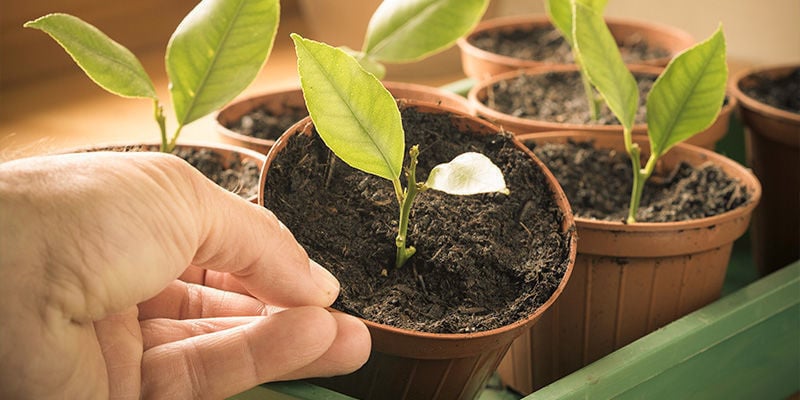
If you want to grow a lime tree indoors, you’re better off starting with a young established plant. Get your hands on the healthiest specimen that your nursery has in stock, and purchase a larger pot (up to 50cm in diameter) while you’re there. Put together a well-draining potting mix, throw in some mycorrhizal fungi powder to enhance root development, and transplant your tree into its new home.
If you have the luxury of a conservatory, then you’ll have a thriving tree in no time! If not, place it on the most sun-exposed windowsill in your home. Failing that, grab yourself a good-quality grow light and keep your tree illuminated for at least six hours each day.
Water your tree only when the soil dries out to a depth of 7cm. Routinely feed using a rich citrus fertiliser once every three months.
Figs

Fig trees are rarely started from seeds because of the precise and lengthy scarification and stratification processes required for optimal germination. However, if you have a friend with a fig tree, or live in an area where they grow feral, you can take a cutting to grow a tree indoors.
To carry out this process, use a sharp and sterile knife and make a cut just beneath a node to take a cutting around 25cm in length. Trim away all of the foliage, leaving just a couple of leaves towards the tip of the cutting. Plant the cutting into a moist but well-draining growing medium, making sure to bury at least two nodes.
Keep your cutting well-watered and positioned in a warm spot that receives indirect sunlight. Roots can take several weeks to develop. Once established, transplant your cutting into a larger pot and place it in full sunlight or under a strong grow light. Apply a liquid seaweed fertiliser once every two weeks and water once the soil becomes completely dry to a depth of 3cm.
Apricots
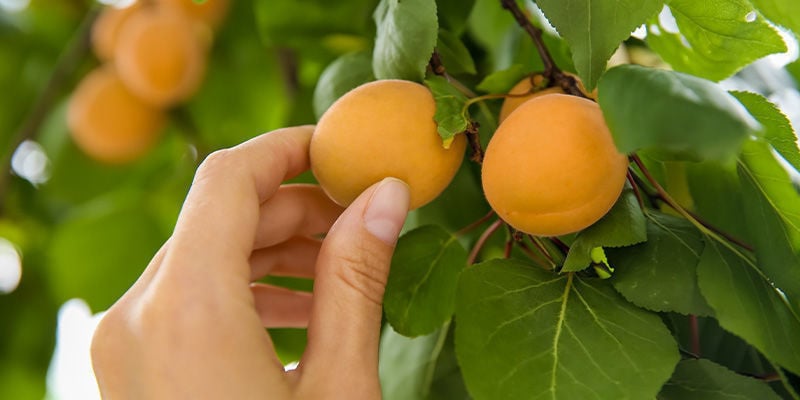
Apricot trees grown from seed can take up to five years before they bear fruit. Rather than wait half a decade to harvest some juicy rewards, save yourself some time and purchase a dwarf and self-pollinating cultivar from your local nursery. Place your plants in a location where they’ll receive around six hours of light per day. Apply neem oil when needed to control pests such as aphids and spider mites.
Fertilise your tree with a balanced water-soluble fertiliser every six weeks. Prune your tree to assist air circulation and to achieve your desired shape.
Olives
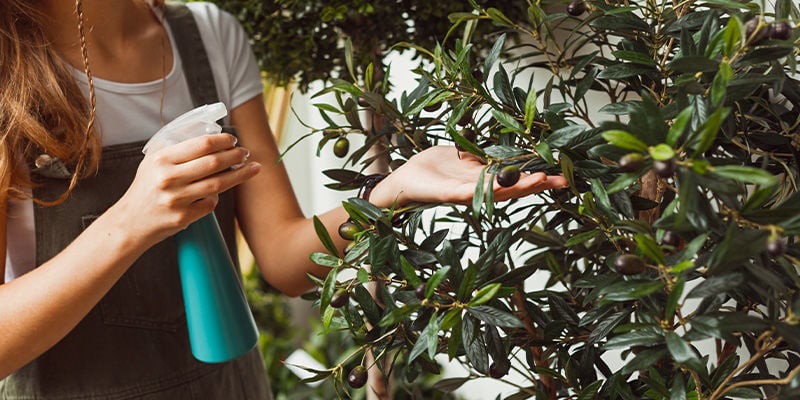
Olive trees require a well-draining potting mix composed primarily of sand and perlite. Place your tree in a sunny location and only water when the top 5cm of soil completely dries out to avoid water-logging. Harness the power of insecticidal soap to tackle pests on-sight. Fertilise sparingly with a slow-release fertiliser to keep your tree healthy and productive. Olive trees only fruit after the age of three, so make sure you purchase a mature specimen if you want a small yield as soon as possible.
Bananas

Indoor banana plants thrive in a well-draining potting mix packed with organic matter. They like ambient brightness but, as jungle plants, don’t require much direct light in order to thrive. It might surprise you to learn that the world of banana cultivation goes extraordinarily deep. Aside from the cloned and seedless Cavendish bananas available in stores across the world, there are a host of different cultivars out there, including red and blue varieties! Types such as Musa Basjoo can grow all the way up the 5m in height. However, the likes of Musa Dwarf grow to just 30cm when kept in small containers.
For the best results, try to keep temperatures around 24°C and apply biweekly feeds of seaweed extract and a high-potassium fertiliser, such as fermented fruit juice made of bananas and other fruits (fruity cannibalism!).
Peaches

Indoor peach plants need at least six hours of direct sunlight each day. Dwarf varieties, such as Prunus Peach Pigmy Bonanza, make a good pick for indoor cultivation in tight spaces. Once you get your nursery plant home, transplant it into a 40–50cm pot containing a standard potting mix and a hefty dose of mycorrhizal fungi.
Fertilise with a product featuring an NPK value of 10-10-10 once per month. Remember to prune your peach tree once per year. Aim to remove any branches growing inwards to create an open and aerated canopy.
Coffee

Yup, that’s right—you can grow these caffeinated beans in the comfort of your own home. Not only will you get to brew up a batch of your own coffee every now and then, but they make an eye-pleasing ornament and are a great conversation starter!
You can get your hands on a good-quality coffee seedling by shopping around at exotic plant suppliers. Once it arrives, prepare a 30cm pot with a well-draining and acidic growing medium. Transplant your precious baby coffee plant and welcome it to its new home with a generous gulp of water. Apply water regularly to keep humidity and moisture levels high, and administer a balanced fertiliser once per month. Once your coffee berries ripen, roast up those beans and enjoy some home-crafted coffee!
Blackberries

Blackberries are hardy plants that practically take care of themselves. Plus, you can pick up mature plants for cheap at practically any garden centre. Transplant into a large container and place it in a conservatory or on a south-facing window sill; they require at least six hours of sunlight per day to produce properly. Add perlite to your growing medium to help drain off excess water and plenty of well-rotted compost to keep your plants well-fed. Top Dress with worm castings every two months to keep the nutrients flowing. Prune your plants back slightly after they finish fruiting to manage their size.
Let fruit flourish in your home
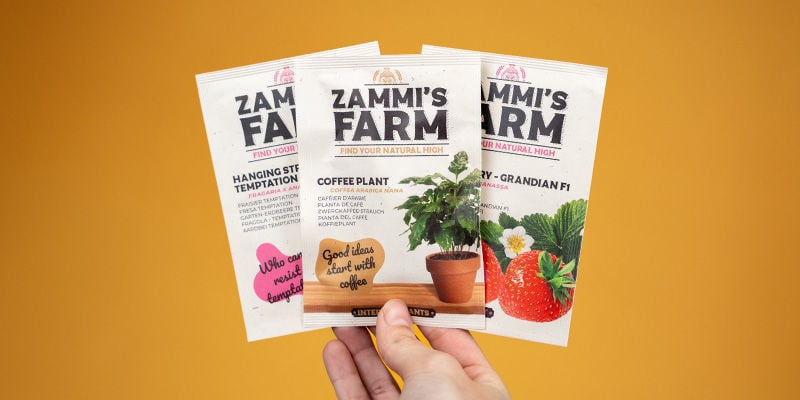
There you have it—you’re now ready to start growing fruit in the comfort of your own home! Sure, you’ll hardly become self-sufficient, but growing these plants indoors serves as an interesting hobby. Plus, you’ll produce a small yield that will taste fresher than anything you can buy off the shelves!
-
 7 min
8 January 2024
Best Fruits And Vegetables For Cold Climates
So, you live in an area with a short growing season? Your garden freezes over late in spring and early in autumn? While you won't have any luck trying to cultivate tropical, heat-loving plants,...
7 min
8 January 2024
Best Fruits And Vegetables For Cold Climates
So, you live in an area with a short growing season? Your garden freezes over late in spring and early in autumn? While you won't have any luck trying to cultivate tropical, heat-loving plants,...
-
 8 min
28 December 2023
The Best Fruits & Vegetables To Grow In Hot Climates
If you're looking to grow your own fruit and vegetables in a warm climate, you're in the right place! First things first, we'll cover the advantages and drawbacks of warm conditions. Then, you'll...
8 min
28 December 2023
The Best Fruits & Vegetables To Grow In Hot Climates
If you're looking to grow your own fruit and vegetables in a warm climate, you're in the right place! First things first, we'll cover the advantages and drawbacks of warm conditions. Then, you'll...
-
 5 min
23 October 2023
Top 10 Special Melon Varieties
In this article, we'll explore 10 special melons that you can grow at home. Whether you're looking for a hands-on grow or a simple experience, and whether you want to eat your fruit raw, in a...
5 min
23 October 2023
Top 10 Special Melon Varieties
In this article, we'll explore 10 special melons that you can grow at home. Whether you're looking for a hands-on grow or a simple experience, and whether you want to eat your fruit raw, in a...





 United States
United States











